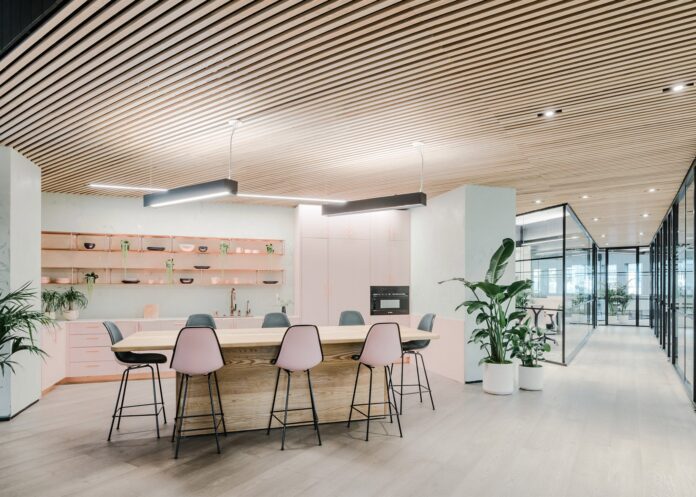The popularization of information and collaboration technologies in the workplace in addition to global economic changes and the requisites of sociability have created a need for flexible office locations that support mobile and collaborative work. Co-working is currently a globally generalizing workplace phenomenon. This study investigates the evolution of co-working places from the 1960s until today to identify the primary concepts and drivers of this development. The main drivers of these concepts relate to new ways of working, attractiveness, work-life balance, economic efficiency, sustainability and regional development.
Today, co-working spaces appear to be the subject of increasing academic discussion (see, e.g. Spinuzzi 2012; Bilandzic and Foth 2013; Parrino 2013). In addition, there is an abundance of commercial material available such as global co-working surveys performed by Deskmag online magazine as well as a variety of guidebooks for new service business. The discussion on the origins of the co-working space phenomenon often focuses on Silicon Valley software programmer Brad Neuberg, who aimed to combine the structure and community of an office job with the freedom and independence of freelance work (see, e.g. Jones, Sundsted, and Bacigalupo 2009; Bostman and Rogers 2010; Parrino 2013).
Co-working refers to the co-localization of a group of individuals with more or less heterogeneous backgrounds in the same work environment (see, e.g. Spinuzzi 2012; Parrino 2013). The facilities and equipment are at least to some extent shared among the users (see, e.g. Bostman and Rogers 2010; Huwart, Dichter, and Vanrie 2012). As a spatial solution, co-working spaces are described as open-plan office environments (Olma 2012; Spinuzzi 2012) with various settings that allow concentrative work, collaboration and social activities (Laing 2013). Separate co-working spaces may differ radically in ambience and amenities (Spinuzzi 2012). Johns and Gratton (2013) defines two types of co-working spaces: spaces created by companies for their own untethered workers to foster employee engagement and innovation and independently operating co-working spaces that serve people who might have previously used local coffee shops or other similar facilities for working purposes. Independent co-working spaces host mobile workers such as freelancers, start-up entrepreneurs, small business owners and permanent employees who often come from small companies (Foertsch 2011a; Spinuzzi 2012; Laing 2013; Parrino 2013).
As a business model, co-working spaces are often viewed as providing a service (Bates 2006) instead of mere square metres. Certain co-working spaces are publicly supported, whereas others are fully privately owned (Huwart, Dichter, and Vanrie 2012). The size of co-working spaces varies from several dozen square metres to entire buildings (Bates 2006).
Based on the literature review, the drivers behind the evolution of co-working places were identified to be new ways of working, attractiveness, work–life balance, economic efficiency, sustainability and regional development. Co-working often includes participatory activities that enhance the collaboration, idea sharing and mutual support among the co-working community (Laing 2013, 2014; Parrino 2013). In these cases, co-working is seen as social working with an emphasis on interaction with other workers (Spinuzzi 2012).
Co-working places may advance the work–life balance of their users. One of the initial aims of telecentres was related to reducing the time spent on commuting by being located near the homes of their users (see, e.g. Mokhtarian 1991; del Águila Obra, Cámara, and Meléndez 2002b). Co-working spaces share similar aims by being located near the everyday activities of their users. Therefore, these spaces are typically located close to users’ homes, clients or desirable amenities, such as day care, popular bars and restaurants (Spinuzzi 2012) and a variety of shopping and other services (Bates 2006) in city centres or other business districts (Bates 2006) or in rapidly gentrifying areas near downtowns and major transportation hubs (Spinuzzi 2012).
To be successful, future co-working place concepts need to be smart physically, virtually and socially. In practise, these requirements mean that the service providers should consider the following issues:
- Mobile co-workers represent a new customer segment for the supply sector. Co-working place providers have a competitive edge by offering users an optimal mobile work location, meaning a density of people and a usable, smart and attractive physical and virtual work environment.
- Co-working places can contribute to the well-being of mobile users by offering the possibility to manage the use of place and time, which increase satisfaction, productivity and mindfulness – in other words, social sustainability.
- Cost-effective short-term leases and payment per use by membership structures make the use of co-working places economically effective and demands business logic applicable from the hospitality industry.
- The diversity of occupants that is typical in co-working locations provides the supplier with the possibility of optimizing user rates and making full use of the space resources as well as avoiding the lost use of resources, which is also an environmentally friendly and sustainable approach.
Analysis
This article carefully pulls apart the different components to co-working spaces and how they’ve evolved to be successfully implemented within the community. One aspect I found interesting that I’d like to dive into further is how the collaboration site should be close to home or work, but also limit distractions of the urban setting. When out of the office, productivity is important to ensure that the time is well spent, according to higher ups in the office. The work environment needs to be designed specifically for the user; making sure there is access to the internet is one of the most important aspects of the design. Without WIFI or internet connection, no one will come. This article also touches on co-working spaces being systems, but with the Dayton space being free, it won’t be managed by a single business. It will be useful to reference this article when understanding the system of the open office plan.




